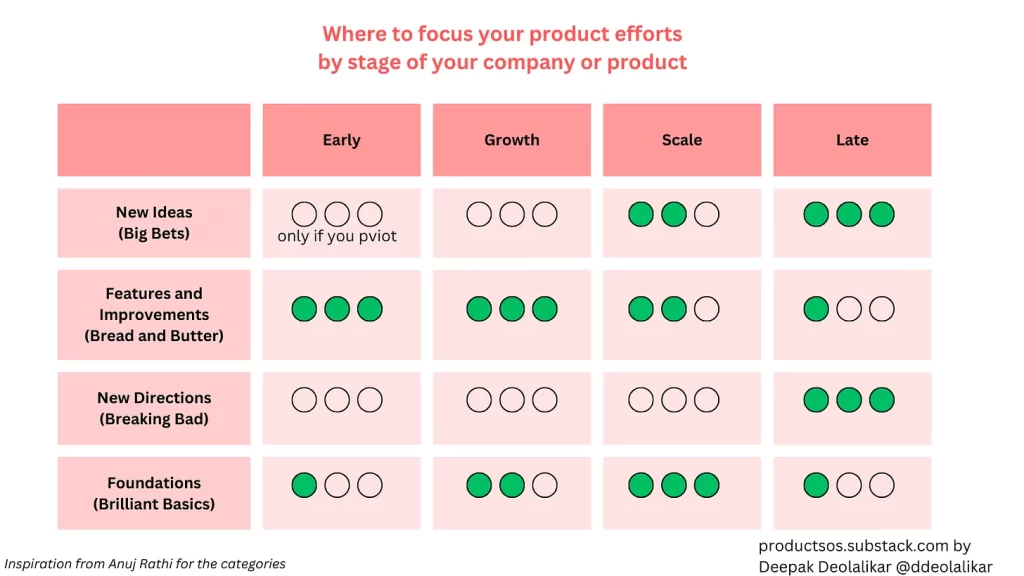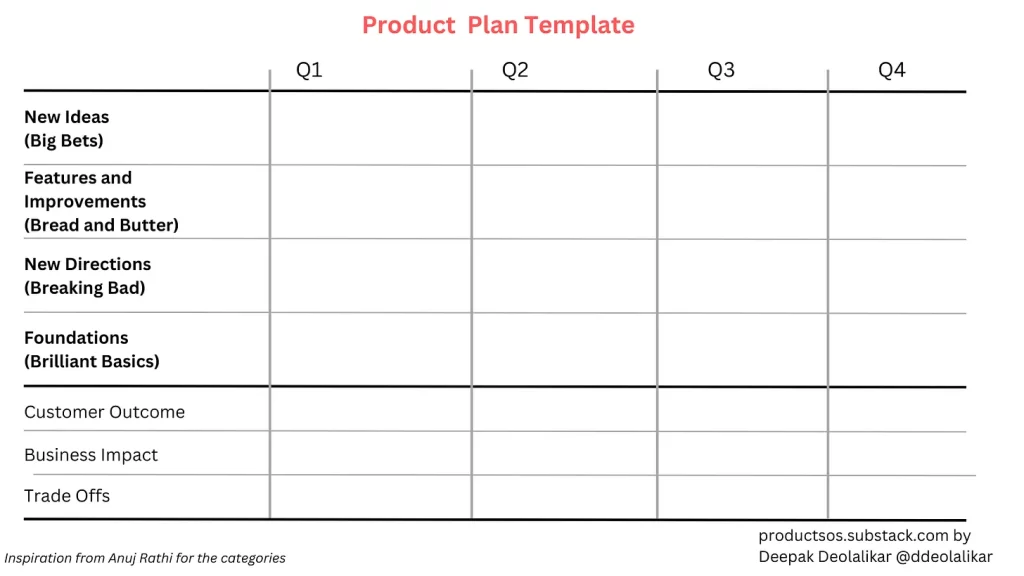Where do you focus your product priorities

A new year or a new quarter brings a new round of product planning. How should you think about prioritizing to build your product plan and get alignment.
Based on your recent customer and market discovery, you have –
- brand new product ideas
- new feature capabilities
- new add on product ideas
- improvements to existing product
- improvements to sign up, activation or adoption
- customer requests
- internal tooling
- build robustness in your product
- automate testing
and so on.
Unless you have unlimited resources, you will need to prioritize from amongst these options.
In @lennysan podcast with @anujrathi, he discussed the 4BBs to consider in your product planning.
- Big Bets
- Bread and Butter
- Breaking Bad
- Brilliant Basics
Let’s understand these categories first :
Big Bets (New Ideas)
These are new ideas or business models for your product.
For example :
- Introducing a self service component for your product
- Adding new or add on product
- Expanding to new industry or GEO
Big bets don’t happen that frequently. These are large initiatives in any company. Significant business impact is expected out of big bets.
Bread and Butter (Features and Improvement)
New features ideas and refinements to your existing products. This is essentially your backlog. Even within these you will have a ton of options and you will prioritize them as per the product strategy.
For example:
- UX Improvements
- New dashboards
- Improve activation flow
- Customer specific asks
- Stakeholder asks
Breaking Bad (New Directions)
This is a rare category for most but these are ideas that require redefining your business or product.
For example:
- OEM your product into another platform
- Refactor business product to a consumer version
- Offering a completely different product or going into a new market. (e.g. Uber eats)
This category of work will require significant discovery, validation and management buy in. The whole company will be involved in making this work.
Once I was involved in splitting our product into multiple SKUs, each with it’s own name, segment, price point and value proposition. This was a big effort and required every department to make changes.
Many companies had to implement Breaking Bads when Covid hit and as they had adapted to new business models.
Brilliant Basics (or Foundations)
A euphemistic term for tech debt, feature debt, design debt and so on. These are continuous improvements to your product that make it more robust, secured and high performing.
For example:
- Improve performance of product
- Eliminate frequent bugs and friction points
- Test automation
So where should you allocate your scarce resources?
This is a bit of an art where your product prioritization really comes into play.
You need to take into account
- Your current revenues (NRR) and customer situation (CSAT)
- Your competitive positioning
- Your product’s stage
- Your resources
- Investment appetite
Let’s start with your product stage. Typically, there are 4 stages to a product or a company.
Early → Growth → Scale → Mature
At each stage of your company, your relative priorities should be different.
Early → Focus more on Bread And Better so that you can sell to more customers that fit your core ICP. At this stage, you don’t want to make any big bets or try something different. Focus is key. While you still have to make sure your product works and performs well, you may be able to wing by a few bugs here and there, unless they are critical.
Growth → Now you are growing to more and more customers of the same type. Product quality will become important as you reach the late adopters who are less forgiving. You will be focused on retention a lot more at this stage so fixing those frequent bugs will be key, while still continuing to add product capabilities for a wider range of customers. This is the most challenging phase for any product team as more and more balls need to be juggled.
Scale → You will continue to do the things you did in growth stages but may want to add some Big Bets. e.g. Grow into a new industry or geo, introduce a new pricing model, create a new add on product.
Mature → If you are a mature product, you would continue to improve the existing product to keep customers satisfied and keep retention high. But you will need to diversify. Take on some big bets to expand. Or do something entirely new.
Here is a helpful summary. This is open to interpretation as each context is different.

Beyond your product stage, there are other factors that will influence your priorities.
Your competitive position in the market. If your position is weak, then you will need to make sure your product works flawlessly to avoid customer churn and stay ahead of the competition. But if you are a leader, then perhaps you can experiment and make some big bets.
You will also need to look into your existing customer situation. If your customer satisfaction is low, then you may want to focus on bread and better and brilliant basics. If customer satisfaction is very good then you can take some big bets or even go after breaking bad items.
Finally, the investment appetite. Say you have convincing proof that doing X will move revenue 30% but requires additional resources. Your company many not have the cash or investment appetite yet. This happens a lot in PE backed companies.
There are a million ways to think and arrange your ideas.
Your discovery, validation, feedback and evidence is going to be used to frame your choices.
And as you choose, you will realize there are trade offs.
Say you focus on Bread and Butter and Brilliant Basics in a given quarter, then management should not expect any new products to sell.
If you focus on Big Bets, then product quality might suffer and support may need to field more tickets.
There is no formula or framework or algorithm at this step. This is the most difficult part of product planning. Your job as a PM is to use your evidence to come up with the best combination of the plan that will help move the revenue needle with the least risk.
Now, your situation may be different. And your product mix might not align with this framework. And thats OK. Just make your own criterion and stick to it. There are no hard and fast rules here.
You will of course need buy in from your management and stakeholders. When you present your plan, make sure to include :
-
Customer outcomes
What are the outcomes that the customer are going to expect? -
Expected business impact
What are the expected revenue add to the business? -
Tradeoffs
What are we not doing what is the impact ?
What kind of tradeoffs should be expected?
If you put lower emphasis on :
- Big Bets, then
- No new products to show to customers.
- Sales and marketing have to consistently work on messaging for the existing product
- Bread and Better, then
- Existing customers may complain and may result in churn.
- No new features may lead to product stagnation
- Breaking Bad, then
- Then you will need to keep growing within your existing market
- Brilliant Basics, then
- Quality might suffer.
- Support may have to field more than usual number of tickets.
Once you have crafted your product plan, use the template below to document your plan.
Use this to get stakeholder as well as management buy in. That way you can be sure that you are not missing any major activities that you should be working on. It is also useful to ensure that all stakeholders are aligned and they adjust their own priorities.

Happy planning.

